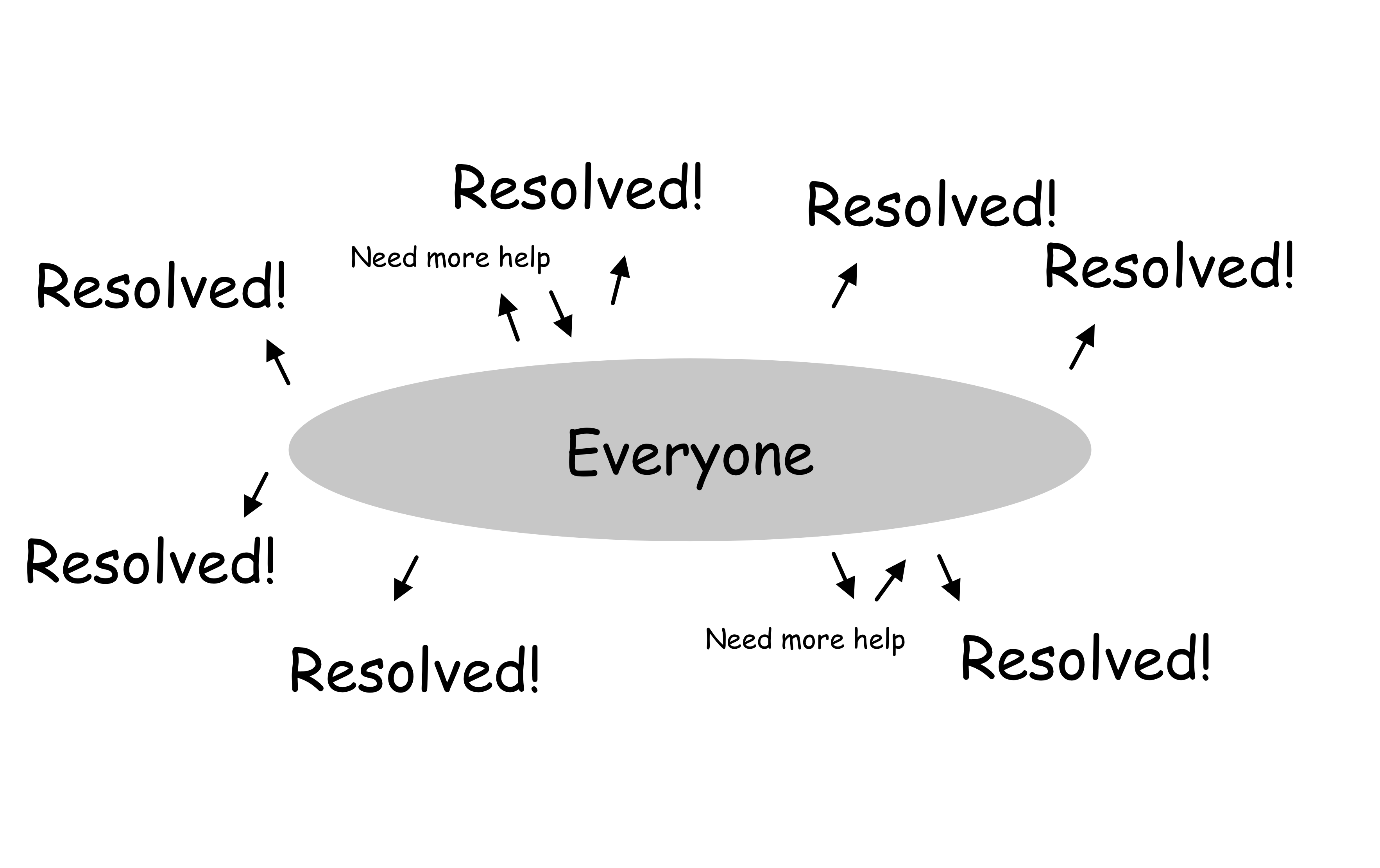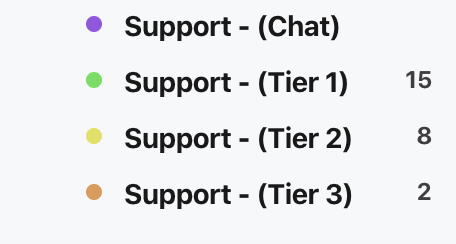When you drive up to the Burger King window and assess your options, it’s immediately clear: the combo is the way to go. Why wouldn’t you want the fries and the large root beer along with your Whopper?
Believe it or not, that same rationale applies for customer support methodologies: the combo is the way to go. Here’s why.
Since the advent of the help desk, there has been debate about the best way to set up your support team. Many organizations swear by a tiered model - where support messages of varying difficulty get escalated from Tier 1, to Tier 2, and so on, with groups of reps responsible for each tier.
Other organizations prefer the collaborative support model, where everyone works together on requests grab-bag style.
Both have their benefits, which we’ll go over below. At Front, we do both - collaborative tiered support. You don’t have to choose between the tiered model or a collaborative support model, and we believe you can (and should) do both in order to give your customers the best possible service.
We’ll walk you through why this is better for customers and teams, and how you can replicate it for your team below.
First, what is a tiered customer support model?
Tiered customer support happens when the team arranges requests into varying levels: Tier 1, Tier 2, Tier 3, and so on. Messages move into different levels based upon certain criteria this could be anything but for this example, well use the popular criteria of request difficulty. Quick and simple requests stay in Tier 1, longer and tougher requests funnel into Tier 2, and highly technical problems live in Tier 3. Support reps with technical knowledge will handle Tier 3. You can visualize it like this:

Whats great about this method is that it provides you with an extra layer of detail around your incoming messages and how long you should spend on each one. Many teams say that around 80% of requests are resolved in Tier 1, and you can put a typical time restraint around these as a guideline maybe each request here takes about 6 minutes to solve. Say 15% of requests require more work 30 minutes per request. These are Tier 2. And last, Tier 3: this is only 5% of your total messages, but they take 2 hours to research and solve.
Of course, this varies for every business, so combing through tickets to get an understanding of your unique ratios and time allocation is a great exercise for any support team leader whether you’ve just started with a new team, or throughout the year as you’re continually looking to approve your customer satisfaction scores.
Benefits of the tiered support model
Clear accountability: Putting clear delineation around messages gives reps an understanding of what they’re responsible for and how long it should take
Metrics-driven approach: You can continually monitor tiers to alter your model to enable you to serve customers faster.
And what is a collaborative customer support model?
The collaborative customer support model is aptly titled: it involves the whole support team working together on requests. This model is sometimes called swarming (no bees involved, I promise), and its a bit like the game hungry, hungry hippos from the 90s. Everyone gets access to all support requests and can grab them and work on them all as a team. Heres what it looks like at a high level:

Now, jumping in and taking over a request can go poorly when you have no idea whats been tried before no customer likes to be asked to restart their computer 3 times by 3 different reps. And, no customer likes to be passed from person to person, having to explain their problem again and again.
Thats why in this method, its important that the entire team have access to all information they might need to appropriately answer questions. You need to be able to see previous conversations the customer has had with your team, their plan or history with your company, details on the problem at hand, and who they’ve spoken to on the team in the past.
How to implement the collaborative support method successfully
The best way to get all this information centralized is through a shared inbox for your messages to [email protected]. The team gets shared access to all the requests and can see the replies of every other support teammate, so full context is available whenever you need it. You can make a shared inbox in Gmail, Outlook, or, Front, which is best but, hey, we might be biased 😅
Benefits of the collaborative support model
Puts the customer first: Every support rep can help impact the customer’s experience and lend knowledge to resolve the issue.
Increased team engagement: Every support rep can see issues being solved and learn from it, meaning they’re constantly being challenged and growing.
Specializing with the collaborative support model
Some support teams like to have reps specialize in certain areas of their product or service, and this can work really well with the collaborative support model. For instance, Samuel is the go-to guy for all new order questions, while Xander works on all refunds. In these instances, you’ll want a way to get those messages directly to your specializers stat. Otherwise you’ll be left forwarding requests around until you find the right person to reply.
This is where having some sort of deeper organizational method becomes critical. In Front, we use message tags to get label messages by what the issue is related to like invoicing or integration. Then using rules, messages with those tags get assigned to the human who knows it best automatically. Boom.
4 critical components of the collaborative customer support model
There are a few infrastructural pieces you need to have in place for your team when you’re moving to the collaborative customer support model. If not, you might find that your messages are unevenly distributed across the team, or your team is stepping on each others toes when replying to customers. Either way, this is not ideal for customers. Heres what you need to have in place:
A way to designate clear message ownership: You need a way for people to understand what is being worked on by someone else, or to understand when the ownership of a conversation has changed.
A single source of truth for messaging: When you’re working the collaborative support model, your whole team needs access to every message across every channel, whether it’s an email, a phone call, or a tweet for help. That lets you get the full scope of every request, and your team has the access to work on them together.
Ability to evenly distribute messages across teammates: If Jodi is completing 90% of the work for the team, you’ve likely got underlying issues with team engagement. Jodi will burn out, and the rest of the team might need mentorship. When you move to a collaborative customer support model, you need to means of ensuring you’re distributing messages to the team fairly — whether it’s exactly even or diced up accordingly by the level of difficulty of the message.
Ability to measure who’s helped with what: When you’re using the collaborative support model, by nature, a message that was initially given to Jamie might end up worked on by Theo and finally answered by Jose. Having analytics on who worked on what is important for truly understanding the dynamics of your team’s service.
All of these are things you can measure in Front, and you can read more about this in our guide to Front as a help desk.
Why both collaborative and tiered support is better
Like I mentioned before, the Front support team uses a collaborative tiered support model. Heres a screenshot of our tiers (these are shared inboxes):

Why do we do this? It enables us to have the best of both worlds and keep the focus on customers.
1. Centering everything around customers
With a collaborative tiered support model, we center everything around our customers. Its about what allows us to get back to them with the best answer fastest. And arranging requests in this way allows us to do that by giving a clear picture of message difficulty but empowering the entire team to work together to solve problems for customers.
2. Clear accountability
We are able to get clear ownership no matter what tier a message is in through assignments in Front. For this, we simply rely on assignments feature in Front.
3. Using data to improve
We can get insights on messages in each tier to understand how long it takes to resolve each type of message, how long it takes for the first reply, the amount of requests each teammate is resolving, and more. To do this, we simply look in Fronts analytics.
4. Collaborating for constant growth and engagement
No matter what tier, we rely on comments in Front to collaborate maybe a Tier 3 support engineer shares a message with an Android developer to talk through an app issue. Or a newly hired rep comments to ask for help from a more tenured support agent in Tier 2. The options are endless, and working so closely together on messages helps the entire team to feel deeply woven part of the team.
2 more initiatives for building a more collaborative customer support program
There are several ways companies promote collaborative support across not only the support team, but with the entire organization. This pays dividends when it comes to customer experience across the board. Companies like Zappos, Stripe, Basecamp, and many more have experimented with getting the entire company on customer service as a means of building a foundation for a more customer-centric brand. And it works! Here are a few options to try:
Use the all hands support model to get everyone in on support
Companies often take the moment they hire their first support rep as the moment when support is no longer a team-wide responsibility, said our first Front Support Rep Cori Morris. But that doesn’t have to be the case. The all hands support model is when your entire company - no matter what team you’re on engages in customer support at some point in their tenure. Teams use it as a way to create empathy for customers and give non-customer-facing individuals a chance to interface with customers.
Quoting from Cori, the all hands customer support builds the backbone of your brand:
Foster an “everyone does support” culture. Whether it’s maintaining a schedule of shifts, highlighting ticket trends at an all hands meeting, or using a transparent platform like Front to make feedback easily visible to the rest of your team — find a way to get your team invested in support. Your customers will thank you!
Help customers help themselves. Keep your knowledge base updated and surface themes from customer feedback to the product team to solve higher order problems. This frees up your time to focus on giving a great experience to customers.
Ask for help when you need it. If you’re stuck on a customer issue, don’t hesitate to escalate it to your team so you can resolve it quickly. There’s the added benefit of keeping customer problems top of mind for your entire organization.
Get marketing in on omnichannel support through social media
Making social media support part of your omnichannel service can be an easy way to make support a collaborative effort cross-functionally. Since social media is typically owned by marketing teams, bringing support and marketing together under this initiative is a popular way to weave customer ideas and issues into marketing language.
At Front, one way we handle this is to have a marketing person (yours truly) own social media handles, such as our Twitter and Facebook inboxes. When a request comes in thats support-related, I do my best to answer it using my product knowledge and our help center. If I need help, my support team is an @mention away. And if its really a doozie, I can simply move it to the Support inbox to be triaged as a regular support request.
The collaborative customer support model goes best with fries
When you’re trying to give world-class customer service and set your support reps up for success, remember: go for the combo.
If you want more details on how to run a combo model you can dig into how we’ve set up an award-winning support team with a collaborative tiered model here at Front, and browse our guide to how you can use Front to deliver better customer support.
Want more insight on how Front views support and trends to stay aware of? We’re proud to have recently made it to a 100% CSAT score and to maintain that high a bar for customer care, we have to adapt to advancements in new technology, including generative AI. Check out new insights from our Head of Support on how to prepare your support team to thrive this year.
Written by Emily Hackeling
Originally Published: 23 June 2023

